Black-Tailed Deer Tracks and Sign
An Online Field Guide
Odocoileus hemionus columbianus
Black-tailed deer are classified as a subspecies of mule (Odocoileus hemionus), which ranges throughout the western United States. These deer are found in forested regions from extreme southern Alaska, along the coast, West of the Cascade crest all the way down to San Francisco Bay area of California. This subspecies does not inhabit the drier, more open habitat of its large relative the mule deer. This species can be recognized by their tails which are oblong in shape and usually totally black or very dark brown on top and white underneath, have reddish-brown coats in the summer and grayish coats in the winter. Also, the males or bucks, have antlers that fork each time they branch, so that each branch divides into two points. Unlike white-tailed deer, which have antlers with points coming off of one main beam. Black-tailed deer feed on a wide variety of plant matter including berries, flowers, herbaceous plants, acorns and fruit as well as twigs and buds in winter time.
Black-tailed Deer Tracks
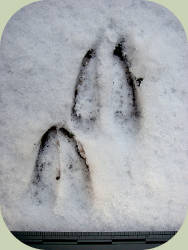
Tracks: The tracks of deer are familiar to many people. Black tailed deer and mule deer leave practically identical tracks, only they are found in different habitat types.
Like all deer, they have 4 toes which end in hooves. Though with mule deer and black-tailed deer, the tracks usually only show the first 2 toes which are much larger. Occasionally in deep substrate or when moving very fast, the smaller rear toes (called dew claws) will register in the track. The tracks are heart shaped overall, with front feet being slightly larger than rear.
Front: generally between 2.5” to 4” long by 1.75” to 2.75” wide.
Rear: generally between 2” to 3.5” long by 1.5” to 2.35” wide.

Gaits: this deer tends to travel at a walk, trot, lope or a pronk. When deer walk the hind tracks tend to fall close too or on top of the front tracks. Walking strides are usually 15-25” long, while in a trot the stride is 33-50” long.
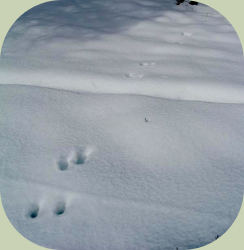
If this deer species feels threatened, it often moves away in a pronk. Pronking involves bound with great leaps, where all 4 feet take off from the ground and land back on the ground together. This is a very effective motion when moving through dense vegetation with fallen trees, or rocky and uneven ground.
Be More Prepared For Your Next Outdoor Adventure!
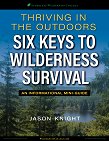
Don't leave without knowing these six essential survival skills. Our free survival mini guide reveals the strategies of:
- Shelter & fire to prevent the number one cause of death
- Obtaining clean water to avoid life-threatening dehydration
- Common wild survival foods and other critical skills!

Black-tailed Deer Sign
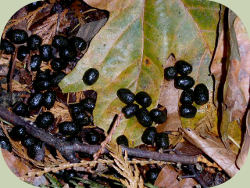
Scat: The scat of black tailed and mule deer appear often as small pellets about the size of chocolate covered raisins or jelly beans. The pellets often have a nipple on one end and a dimple on the opposite end. When the deer feed on a large amount of moisture rich vegetation, the scat can appear as a softer, more amorphous mass.
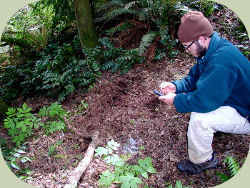
Other Sign: this deer species also leave behind other sign such as beds, antler rubs and feeding signs. Beds are generally oval or oblong, sometimes with the impressions of knees visible and very often with hair deposited in and around the bed. They usually measure about 25-42” long.
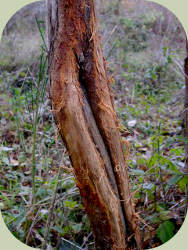
The antler rubs are generally found on the lower trunks of small saplings and generally measure between about 10” and 45” off the ground. The rubs can be worn smooth in the center, with clumps of bark and hair deposited at both the bottom and top of the rub.
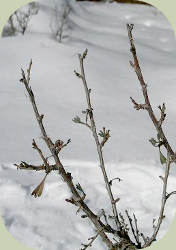
Deer feeding sign can be seen on the plants which deer like to feed on. When deer browse on vegetation, they tend to leave ragged edges or ends to the parts where they have bitten of vegetation.

Feeding sign on soft materials, such as mushrooms, can show a large bite mark. Take care to look at all the details, as other species of mammals also feed on mushrooms.
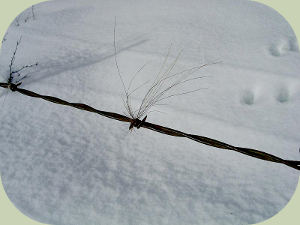
When deer cross over or under fences, they often leave behind hair. In this case, it is caught on the barbs of a barbed wire fence. Deer hair is hollow and kinks when bent. It can be confused with the hair of other large ungulates.
Similar Tracks: Black-tailed deer tracks can be confused with other members of the deer family. Please see this article for a comparison of deer tracks versus other similar tracks: https://www.wildernesscollege.com/identify-deer-tracks.html
Further Resources
Black-tailed Deer: Ghost of the Pacific
Learn about Alderleaf's Wildlife Tracking Courses.
References: Elbroch 2003, Halfpenny 1999, Murie 1954, Rezendes 1999.
By the way, when you're out tracking or looking for wild animals, it's important to know how to stay safe in the outdoors, especially if you were to get lost. Right now you can get a free copy of our mini survival guide here, where you'll discover six key strategies for outdoor emergencies, plus often-overlooked survival tips.

About the Author: Filip Tkaczyk is a periodic guest teacher at Alderleaf. He also wrote the field guide Tracks & Sign of Reptiles & Amphibians. Learn more about Filip Tkaczyk.

Return from Black-Tailed Deer Tracks back to Wildlife Tracking Articles
Is The Essential Wilderness Survival Skills Course Right for You? Take the "Online Survival Training Readiness" Quiz
See for yourself if this eye-opening course is a good fit for you. It takes just a few minutes! Get your Survival Training Readiness Score Now!

Grow Your Outdoor Skills! Get monthly updates on new wilderness skills, upcoming courses, and special opportunities. Join the free Alderleaf eNews and as a welcome gift you'll get a copy of our Mini Survival Guide.

 The Six Keys to Survival: Get a free copy of our survival mini-guide and monthly tips!
The Six Keys to Survival: Get a free copy of our survival mini-guide and monthly tips!
Learn more